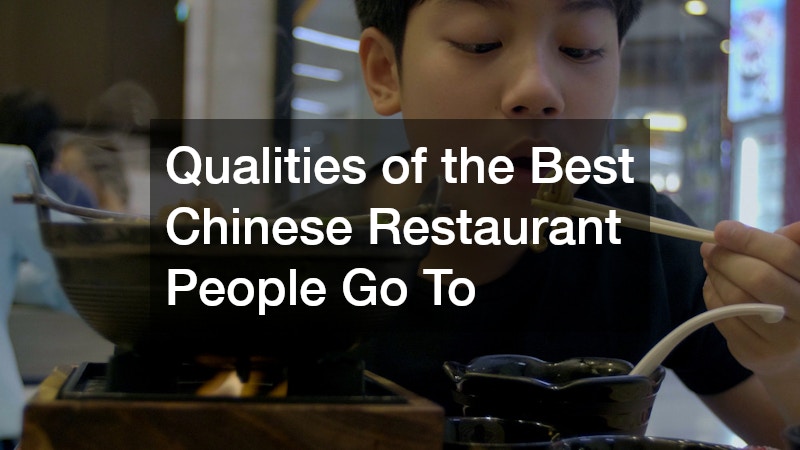Discovering what makes a Chinese restaurant stand out can be a delightful exploration. From the authenticity of the dishes to the ambiance and service, several factors contribute to the allure of the best Chinese restaurant. This article delves into the key elements that make these dining experiences exceptional, drawing in patrons from all walks of life.
How to Identify Authentic Chinese Cuisine?
A Diverse Range of Dishes
Authentic Chinese restaurants offer a wide array of dishes representing different regions, highlighting the richness in flavors and cooking styles. Whether it’s the fiery heat of Sichuan dishes or the nuanced sweetness of Cantonese cuisine, variety is a vital component. Patrons can embark on a culinary journey across China, experiencing the distinctive tastes of each province.
The availability of traditional regional specialties helps differentiate a genuine establishment from generic ones. Offering classic dishes like Peking duck, dim sum, and regional hot pots showcases the depth of authentic Chinese cuisine. A true hallmark of authenticity lies in a menu that honors the diverse heritage of China’s culinary landscape.
In addition to variety, the harmony of flavors and textures is often a reflection of true Chinese cooking. Each dish is crafted with balance in mind, from the crunchiness of stir-fried vegetables to tender meat dishes. This meticulous attention to detail enhances the overall dining experience, ensuring satisfaction with every bite.
Use of Fresh and Traditional Ingredients
The use of fresh vegetables, meats, and traditional sauces is key to authenticity, ensuring the dishes reflect true Chinese flavors. Ingredients like ginger, garlic, and scallions are staples in many authentic recipes, providing depth and originality. The freshness of ingredients not only enhances flavor but also supports a dedication to quality.
Traditional Chinese cooking also emphasizes the importance of seasonal ingredients, adjusting recipes to reflect what’s freshest at any given time. This approach to sourcing ingredients speaks to a commitment to authenticity and heritage. By integrating local and seasonal produce, chefs honor the time-honored traditions of Chinese cooking.
Authentic establishments take pride in creating their own sauces, such as hoisin and black bean, which are fundamental to numerous dishes. These house-made sauces add unique flair and authenticity, something that pre-packaged alternatives cannot offer. Such details underscore the effort and craftsmanship involved in curating genuine Chinese culinary experiences.
Cooking Techniques that Honor Tradition
From stir-frying to steaming and roasting, authentic cooking methods are a hallmark of a genuine and best Chinese restaurant experience. Each technique is steeped in history, passed down through generations, and forms a vital component of China’s culinary identity. Mastery of these traditional methods enhances the authenticity of a restaurant’s offerings.
Stir-frying is among the most popular techniques, valued for its ability to blend flavors quickly and efficiently while preserving the nutritional value of ingredients. Steaming, often seen in dim sum and fish dishes, maintains the purity and natural flavors of the components, celebrating simplicity and elegance. These methods are not only traditional but also inherently tied to the philosophy of balance and health, which is central to Chinese cuisine.
Another significant technique is roasting, particularly in dishes such as Peking duck, where expertise is required to achieve crispy skin and succulent meat. The time and precision involved in these methods highlight a dedication to maintaining traditional flavors and textures. Through these timeless techniques, restaurants offer patrons an authentic taste of China.
What Enhances the Dining Experience?
An Inviting and Cultural Ambiance
The ambiance, characterized by traditional Chinese decor and music, plays a significant role in enhancing the dining experience. Intricately carved panels, lanterns, and silk paintings often adorn the interiors, evoking a sense of elegance and warmth. Such design elements transport diners to another world, allowing them to immerse themselves in the rich culture of China.
A harmonious blend of traditional and modern elements creates an inviting atmosphere that appeals to a broad audience. Soft, soothing music often complements the visual aesthetic, aiding relaxation and enhancing enjoyment. A well-curated ambiance not only sets the mood but also elevates the overall dining experience.
Exceptional Customer Service
Courteous, knowledgeable, and attentive staff can transform a meal into a memorable dining experience. A well-trained team not only provides efficient service but also offers insights into the menu, enhancing guests’ understanding and appreciation of each dish. When staff members are passionate about sharing their heritage, it elevates the authenticity and enjoyment of the meal.
Attention to detail in service, such as recommending the perfect dish pairing or accommodating dietary preferences, can significantly enhance the patron’s experience. Such personalized service creates a welcoming atmosphere where diners feel valued and catered to. The relationship between staff and patrons often extends beyond the meal, fostering a sense of community and loyalty.
Family-Friendly Atmosphere
A family-friendly environment, offering communal dining and a welcoming space, appeals to both local patrons and visitors. Round tables and lazy Susans facilitate inclusive dining experiences, encouraging sharing and interaction among guests. This communal style of dining is a cherished aspect of Chinese culture, promoting unity and connection over a shared meal.
The emphasis on family extends to menu offerings, with large portions and dishes designed for sharing. This format encourages diners to try a variety of tastes, enriching their overall experience and allowing them to create lasting memories together. Family-friendly dining spaces are designed to accommodate diverse groups, from small families to large gatherings, ensuring everyone feels welcome.

